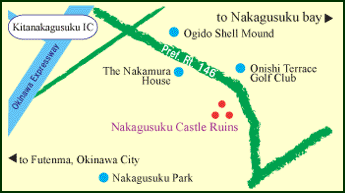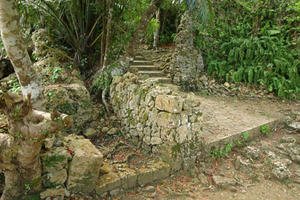Nakagusuku Castle
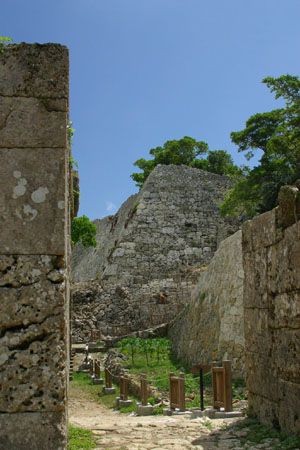 The ruins of Nakagusuku Castle face the Pacific, overlooking Nakagusuku Bay and located on a plateau of Ryukyuan limestone approximately 150 meters in elevation
The ruins of Nakagusuku Castle face the Pacific, overlooking Nakagusuku Bay and located on a plateau of Ryukyuan limestone approximately 150 meters in elevation
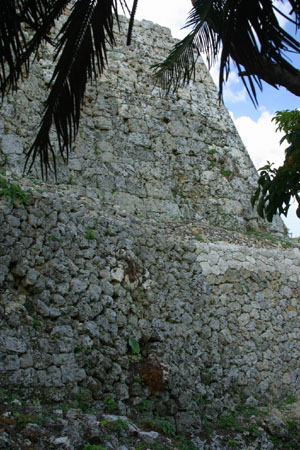 The ruins consist of six enclosures, with the main gate on the west side and a rear gate built in the back. Entering the Gusuku through the main gate, the first long and narrow wall of the western enclosure stretches out. This area was used in ancient times to conduct cavalry drills. Going down to the left side of the western enclosure there is a well. Opposite the well and passing through the left hand stone gate there is a place thickly covered by foliage where prayers are offered.
The ruins consist of six enclosures, with the main gate on the west side and a rear gate built in the back. Entering the Gusuku through the main gate, the first long and narrow wall of the western enclosure stretches out. This area was used in ancient times to conduct cavalry drills. Going down to the left side of the western enclosure there is a well. Opposite the well and passing through the left hand stone gate there is a place thickly covered by foliage where prayers are offered.
It is an Utaki, or sacred grove, where prayers for rain were once offered up to faraway Shuri and sacred Kudaka Island. The whole of the southern stone wall enclosure includes this sacred grove. In the ramparts of the southern enclosure are openings for firing through the walls in the event the castle became a battle zone.
Progressing toward the back, the southern enclosure passes through the first, second, and third stone wall enclosures, with the third going into the northern enclosure. Moving onto the small open space with an arch in the southern walls and onto the first enclosure is the highest location in the whole of the ruins, once the widest of the stone wall enclosures. The main house of the historical Aji chieftains was probably built here.
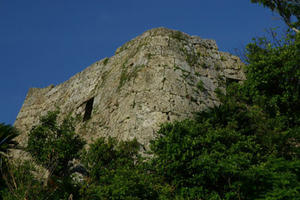 From this wall the second enclosure is reached by going through the stone gate. The gate to the third enclosure is not existent. Entrance into the third enclosure is structured so it goes once into the northern enclosure, where one must pass a flight of stone steps. Masonry on
From this wall the second enclosure is reached by going through the stone gate. The gate to the third enclosure is not existent. Entrance into the third enclosure is structured so it goes once into the northern enclosure, where one must pass a flight of stone steps. Masonry on
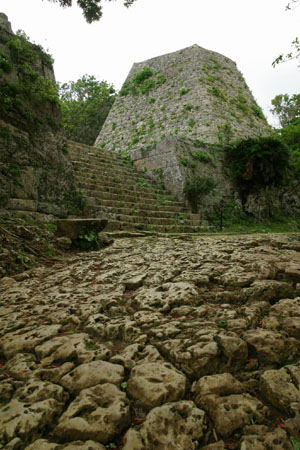
the ramparts that surround the third enclosure is characterized by the large-sized stones used; these were part of another castle wall. While there is "Nunodzumi" coursed masonry used in other walls, the one here used the "Aikata" fitted masonry technique for construction. This is assumed to be due to differences in the age of construction. This is where the strong opinion that Gosamaru enlarged the castle wall when he relocated to Zakimi Castle comes from. This is given credence by the fact that the same techniques were used in Gosamaru's construction of Zakimi Castle.
Nakagusuku Castle was renowned for being the residence of the great commander Gosamaru, but the castle was also the headquarters for a number of historically powerful Aji chieftains previous to Gosamaru's residence. It is traditionally believed that it was built in the 13th century when King Eiso, as Nakagusuku Aji, appointed his own son to construct it.
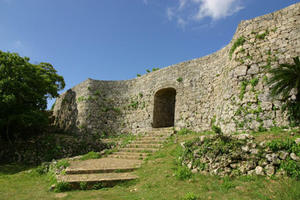 According to official histories, from the standpoint of keeping a sharp eye on the increasing strength of Katsuren, Nakagusuku Castle was in the perfect location. For this reason, Gosamaru, highly honored throughout the whole of the Ryukyus as a military commander and Aji chieftain of Yuntanza, was posted here. While there is a rough idea of Gosamaru at Nakagusuku confronting Amawari of Katsuren, it is not possible to corroborate if Amawari was in confrontation from the beginning within the histories.
According to official histories, from the standpoint of keeping a sharp eye on the increasing strength of Katsuren, Nakagusuku Castle was in the perfect location. For this reason, Gosamaru, highly honored throughout the whole of the Ryukyus as a military commander and Aji chieftain of Yuntanza, was posted here. While there is a rough idea of Gosamaru at Nakagusuku confronting Amawari of Katsuren, it is not possible to corroborate if Amawari was in confrontation from the beginning within the histories.

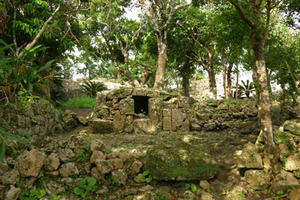 After Gosamaru took his position at Nakagusuku Castle, it was fortified and the third stone wall enclosure facing Katsuren to the northeast was added along with the northern enclosure. While Gosamaru and Amawari faced off but did not attack each other, an extremely short-lived reign of a king in the Chuzan court at Shuri ended in 1453 with succession problems. This led to the "Shiro-Furi Disturbance" and the burning of Shuri Castle. With instability in Chuzan,sixth king Sho Taikyu arranged the marriage of his daughter Momoto Fumiagari to Amawari. Cementing relations through marriage, the king's hidden intention was to restrain the pressure from Amawari. Additionally, King Sho Taikyu's wife was a daughter of Gosamaru, so with Momoto Fumiagari married to Amawari there was a formal kinsman relationship.
After Gosamaru took his position at Nakagusuku Castle, it was fortified and the third stone wall enclosure facing Katsuren to the northeast was added along with the northern enclosure. While Gosamaru and Amawari faced off but did not attack each other, an extremely short-lived reign of a king in the Chuzan court at Shuri ended in 1453 with succession problems. This led to the "Shiro-Furi Disturbance" and the burning of Shuri Castle. With instability in Chuzan,sixth king Sho Taikyu arranged the marriage of his daughter Momoto Fumiagari to Amawari. Cementing relations through marriage, the king's hidden intention was to restrain the pressure from Amawari. Additionally, King Sho Taikyu's wife was a daughter of Gosamaru, so with Momoto Fumiagari married to Amawari there was a formal kinsman relationship.
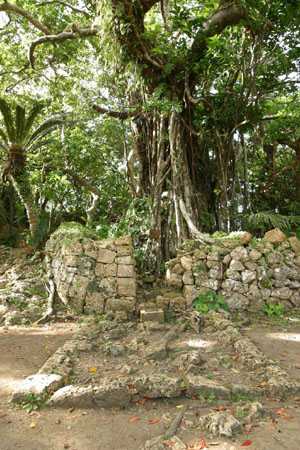 While it appeared there was peace for the time being, official histories relate that the Gosamaru-Amawari Disturbance broke out in 1458. The intrigue surrounding the destruction of Gosamaru by Amawari and the warning of the latter's
While it appeared there was peace for the time being, official histories relate that the Gosamaru-Amawari Disturbance broke out in 1458. The intrigue surrounding the destruction of Gosamaru by Amawari and the warning of the latter's
plans to attack Chuzan given by Momoto Fumiagari and her vassal Oni O-gusuku (Ogusuku Kenyu) led King Sho Taikyu to immediately attack Amawari. History that has been handed down paints a picture of military commanders living in a shifting world revolving around loyalty and treachery.
It is said that when the Chuzan army led by Amawari surrounded Gosamaru, he committed suicide with his wife and children.
There are accounts that mention that as Gosamaru rose to become such a great commander, it would not be so hard to believe he had ambitions to usurp the monarchy and that for the king, both Gosamaru and Amawari were threats.
(Nakagami-gun, Nakagusuku Village), Designated Historical Site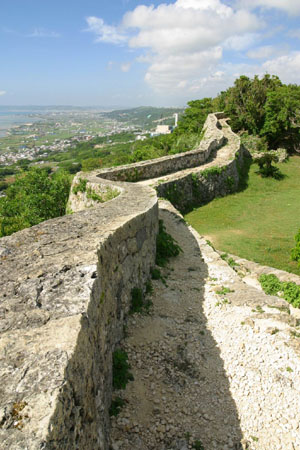 In order to check the resistance of Amawari, lord of Katsuren Castle, the Shuri king ordered his vassal Gosamaru to move to Nakagusuku Castle from his former residence at Zakimi Castle. This castle served an important role in the process of stabilizing the power base of the Ryukyuan king. It is a designated historic sight.
In order to check the resistance of Amawari, lord of Katsuren Castle, the Shuri king ordered his vassal Gosamaru to move to Nakagusuku Castle from his former residence at Zakimi Castle. This castle served an important role in the process of stabilizing the power base of the Ryukyuan king. It is a designated historic sight.
Management / Inquiries
*The Ruins of Nakagusuku Castle Site Management Association
503 Oshiro, Nakagusuku Village, Okinawa 901-2314 Japan
Phone: (098)935-5719
Kitanakagusuku Board of Education Lifelong Learning Section
435 Chunjun, Kitanakagusuku Village, Okinawa Prefecture 901-2392
Phone: (098)935-3773
Nakagusuku Board of Education Lifelong Learning Section
190 Asato, Nakagusuku Village, Okinawa 901-2407 Japan
Phone: (098)895-3707
[USE GUIDE]
Viewing Hours: 8:30 AM - 5:00 PM
Admission:
| Adult: | 300Yen | (Groups: 200 Yen per person) |
| Junior / Senior High Students: | 200Yen | (Groups: 100 Yen per person) |
| Primary School Students: | 100Yen | (Groups: 50 Yen per person) |
Adults that accompany children not yet in primary school are admitted free of charge.
Groups: Over 20 persons
[Map]